Description and Requirements
The Book
Bibliography
Syllabus
 Introduction
Introduction The Great Pyramid
The Great Pyramid Music of the Spheres
Music of the Spheres  Number Symbolism
Number Symbolism  Polygons and Tilings
Polygons and Tilings  The Platonic Solids
The Platonic Solids  Roman Architecture
Roman Architecture  Number Symbolism in the Middle Ages
Number Symbolism in the Middle Ages  The Wheel of Fortune
The Wheel of Fortune  Celestial Themes in Art
Celestial Themes in Art  Origins of Perspective
Origins of Perspective  What Shape Frame?
What Shape Frame?  Piero della Francesca
Piero della Francesca  Leonardo
Leonardo  Façade measurement by Trigonometry
Façade measurement by Trigonometry  Early Twentieth Century
Art
Early Twentieth Century
Art Dynamic symmetry & The Spiral
Dynamic symmetry & The Spiral  The Geometric Art of M.C. Escher
The Geometric Art of M.C. Escher  Later Twentieth Century Geometry Art
Later Twentieth Century Geometry Art  Art and the Computer
Art and the Computer  Chaos & Fractals
Chaos & Fractals
EARLY TWENTIETH-CENTURY
GEOMETRIC ART
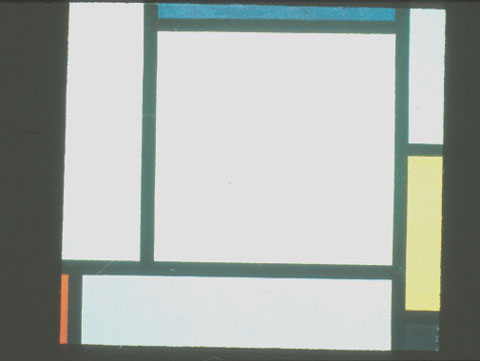
Slide 19-12: Mondrian: Composition, 1933
In this unit we will show some of the roots of geometric abstraction in the Twentieth Century, and present an overview of some of the early movements.
Up to now we've seen paintings, sculpture, and architecture that had geometric elements: geometric figures, particular ratios like the golden ratio and the musical ratios, and where space was organized by the geometric perspective construction. But now, we have paintings and sculpture that is totally geometric.
We've already seen decorative ornamentation that was completely geometric, with no recognizable elements. But these are not decorative ornaments; this is high-class art found in museums and galleries. This kind of art is called geometric abstraction.
| Outline: | |
| Geometric Abstraction | |
| The Scientific Revolution | |
| Cubism | |
| Constructivism | |
| Summary |
Geometric Abstraction
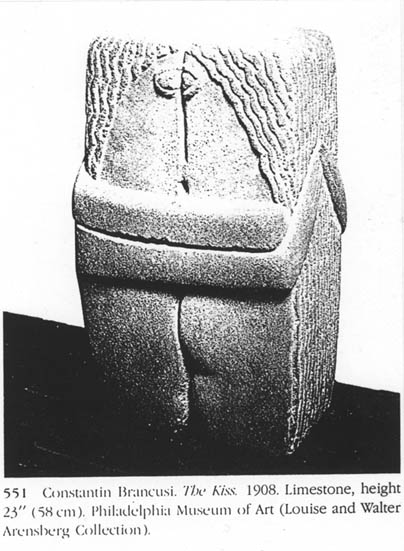
OT 1: Brancusi: The Kiss, 1908
Three Main Currents
The art historian H.W. Janson sees three main currents in art, beginning near the start of the century, Expression, Fantasy, and Abstraction.
Expression deals with feelings, and the concern with the human community. These artists stress their emotional attitude towards the world. Imagination and fantasy explore the the labyrinth of the mind, and Abstraction stresses order and the formal structure of the work.
The best works have all three:
Without feeling we are unmoved.
Without imagination, we are bored.
Without order, we see chaos
In each of these, works have been made ranging from realistic to non-representational (non-objective). In this unit we are going to examine non-representational abstraction; in particular, geometric abstraction.
What is Geometric Abstraction
Starting around the turn of the century there was a complete rejection of literary academic art - artists didn't want to just make a copy of a real object - the newly-invented camera could do that faster and better. They didn't want to make an an illustration for a story. They rejected Alberti's istoria or history painting in which part of the painting's power came from the story it illustrated. The phrase storybook realism became a term of derision
The idea now was that one doesn't paint about anything - one just paints.
The old visions were worn out. Artists wanted to create something that did not exist before, to see the world in new ways, to talk about their inner world, to grapple with large ideas that were universal and utopian.
Abstract art is an attempt to analyze and simplify what we see, to pick and choose. But a work can be abstract, like Brancusi's Kiss, and still be representational, while the Mondrian shown at the start of this unit is completely non-representational.
Let's try to trace the steps that took us from the impressionist landscapes of the late 19th century to total geometric abstractions of the twentieth.
The Scientific Revolution
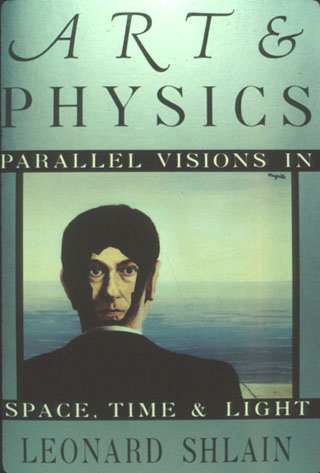
Slide 19-1: Shlain: Art and Physics, cover
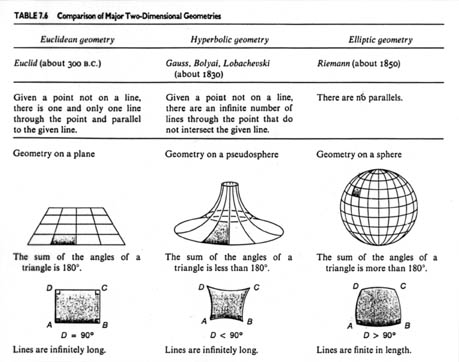
OT 2: Comparison of Major Two-Dimensional Geometries. Smith, The Nature of Mathematics, p. 501
Art isn't created in a vacuum. It usually reflects what is going on elsewhere in a culture.
One thing that was happening at the start of our century was a scientific revolution
It appears that at the start of the our century science and art once more were ready for new concepts of space and time. Some new space concepts came in geometry with the Non-Euclidean Geometries of Bolyai, Lobachevski, and Riemann in the mid ninteenth century. New time concepts came with Einstein's theories, the special theory of relativity, 1905 and the general theory of relativity, 1915.
Influence of photography
About 1883, American inventor George Eastman produced a film consisting of a long paper strip coated with a sensitive emulsion. In 1889 Eastman produced the first transparent, flexible film support, in the form of ribbons of cellulose nitrate. The invention of roll film marked the end of the early photographic era and the beginning of a period during which thousands of amateur photographers became interested in the new process.
In the early 20th century, commercial photography grew rapidly, and improvements in black-and-white photography opened the field to individuals lacking the time and skill to master the earlier, more complicated processes. The first commercial color-film materials, coated glass plates called Autochromes Lumière -- after the process developed by French inventors Auguste and Louis Lumière -- became available in 1907. During this period, color photographs were produced with the three-exposure camera.
This prompted a move away from representation and realism and towards abstraction. If you can capture a scene with the snap of the shutter then why sit there for hours copying it in paint.
Muybridge, Eadweard (1830-1904), English-American photographer and motion picture pioneer, known for his photographs of animals and people in motion. In 1877 he demonstrated through photographs that when a horse runs, there is a moment when all of the animal's feet are off the ground, and that the feet are tucked beneath the animal at that moment. In 1881 he invented the zoopraxiscope, a device by which he reproduced on a screen horse races, the flights of birds, and athletic contests. He wrote The Horse in Motion (1878) and Animal Locomotion (11 vol., including 100,000 photographic plates, 1887). Portions of the latter work were published under the titles Animals in Motion and The Human Figure in Motion (1901).
Through Pictures such as these people became used to seeing figures or parts of figures at the same time
Simultaneity
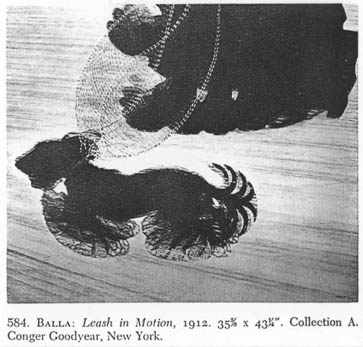
OT 4: Balla: Leash in Motion, 1912
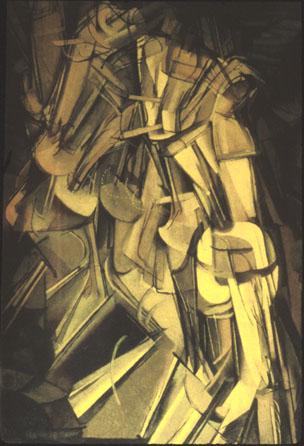
Slide 19-2: Duchamp: Nude Descending a Staircase, 1912(Jan 776)
Some works that show a time element include those by the Italian Futurists, who sought means of expression compatible with the modern industrial world, and Nude Descending a Staircase, nicknamed "Explosion in a Shingle Factory." In the Armory Show in 1913, it needed to be protected by guards.
The Fourth Dimension
There seemed to be a lot of fascination with the fourth dimension early in this century, but it meant different things to different people:
- Time is often considered the fourth dimension in the space-time continuum with three space dimensions and one time dimension.
- Color has been described as a dimension.
- For some artists the fourth dimension appears to have been a metaphor for liberation from the conventions of linear perspective.
- To some philosophers it was a physical reality to which we have limited access.
- To many mathematicians, the fourth dimension simply means an abstract space described in terms of four mutually perpendicular axes.
Hypercube
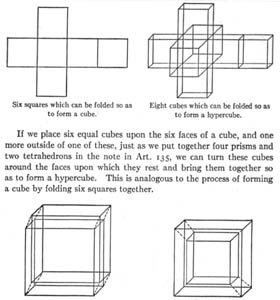
OT 5: Hypercube, Manning p. 240
One four-dimensional object is the hypercube, shown here in an illustration from a textbook on geometries of higher dimensions. It shows how a hypercube can be folded from 8 cubes, just as a regular cube can be folded from 6 squares.
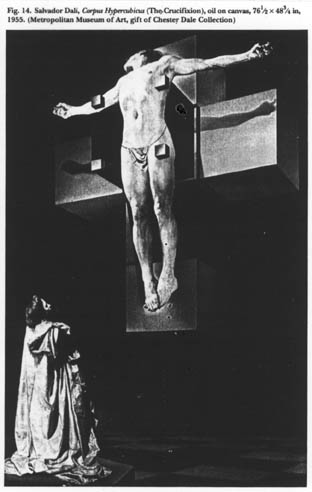
OT 6: Salvador Dali: Corpus Hypercubicus, 1955
Here the artist Salvador Dali has used an unfolded hypercube as a cross.
Cubism
Cubism's Two Parents
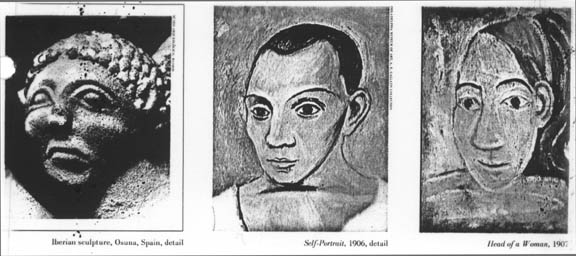
OT 7: African mask, Iberian sculpture
Geometric art has its roots in cubism. Cubism, on the other hand, was born of two parents: primitive art and Cezanne.
Cezanne Cubism
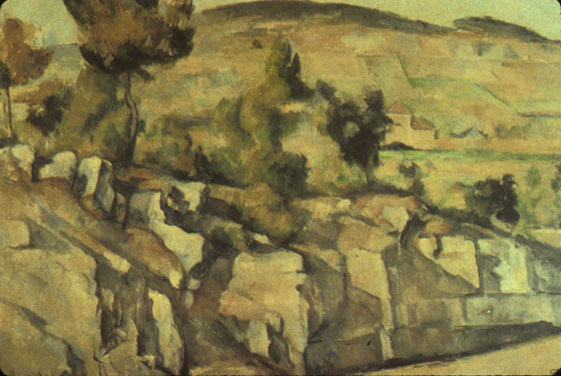
Slide 19-3: Cezanne: Rocky Landscape at Aix, 1887. (Harris p. 67)
In fact, the first stage of cubism is even called Cezanne Cubism. Note that the areas of the painting are becoming simplified and more geometric.
Braque
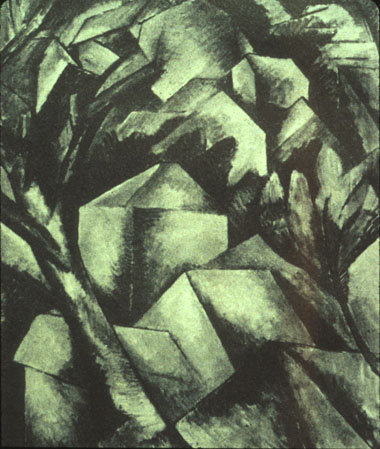
Slide 19-4: Houses Near l'Estaque. George Braque 1908. Cat #2578, p. 158 (Wolfe p. 8)
The very name Cubism came from this painting. When the critic Vauxcelles saw this painting he said the houses "look like a bunch of little cubes." He meant the comment to be insulting but the name Cubism stuck.
Kinds of Cubism
Cubism is sometimes broken down into three kinds by art historians:
Facet, Collage, and Analytical
This first stage, Cezanne cubism, is also called facet cubism, because of the different planes or facets. The stage called analytical cubism is typified by two or more views of a subject being given at once.
Analytical cubism
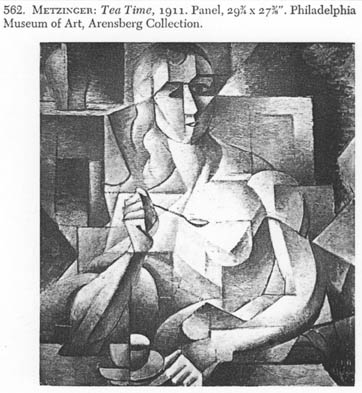
OT 3: Metzinger: Tea Time, 1911 "Mona Lisa with a Teaspoon."
These new ways of looking at the world may have influenced artists to introduce time into their works, as in Tea Time. Note that the face is both profile and front view, and the cup is both side and top view. It shows simultaneity, as if one were walking around the scene. This is also an attack on perspective, which gives the scene from a single viewpoint.
Loss of Perspective
In a revolution old ideas are tossed out. We've already scrapped representation and storybook realism at the start of our century. Another discarded idea was perspective.
Perspective was used extensively up to the end of nineteenth century. But now the artist was saying, This is a painting, not a window. This painting is about itself, not about something out there.
Flatness
Cubism, for the first time since the Renaissance, dispensed with the need to produce an accurate copy of external reality. It acknowledged that a painting is a flat surface on which colored patches of pigment are arranged.
Constructivism
Collage cubism
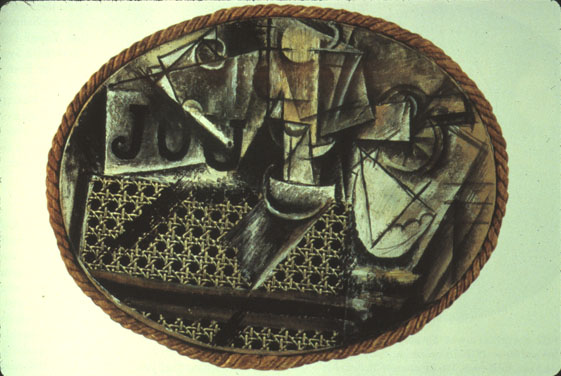
Slide 19-5: Picasso: Still life with chair caning. 1911-12 (Janswon 771)
Braque was one of the pioneers of Cubism, but Picasso is credited as being the real creator of abstraction.
Up to now, all sculpture carved or modelled from a monolithic lump of material. But another branch of Cubism changed all that. As perspective was dropped images moved forward to the picture plane. Some images went even further and invaded the viewer's space, when Picasso and Braque invented the next stage of cubism, called collage cubism.
Collage = paste-up. Stuff glued on, paint added later.
This too, was something new in the history of art. Thick pictures are nothing new, recall Donatello's Feast of Herod. But collage is different from relief carving. It comes out from the picture plane instead of being carved in. It is built up.
Constructions
OT 8: Picasso: Guitar, 1912 and Violin, 1913-14
Collage was followed by Picasso's and Braque's openwork sculpture. Led to many sculptures that were built up, piece by piece, called constructivism.
Negative Space
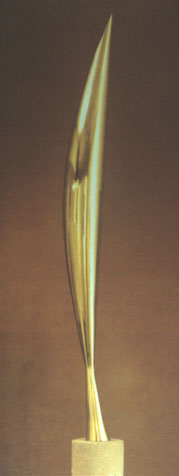
Slide 19-13 Brancusi: Bird in Space,1928 (Janson 818)
Of course, monolithic sculpture didn't dissapear.
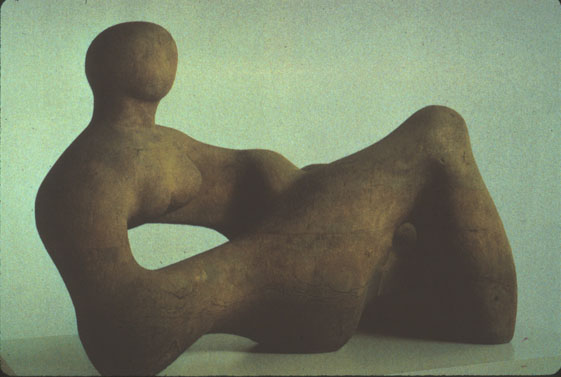
Slide 19-7: Henry Moore, Recumbent Figure, 1938. Janson p. 826
But now the open spaces, or negative space, played a more important role than before,
and many sculptures had holes.
Russian Constructivism
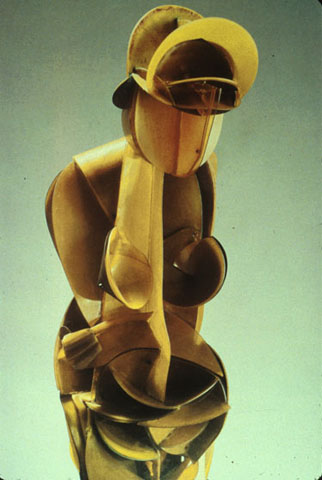
Slide 19-8: Antoine Pevsner: Torso, c. 1925(Dab. 94)
Constructivism popular with Russian artists, like Pevsner and Gabo. But Russian Constructivism got tangled up with Communist doctrine, the role of the artist-engineer, the production of utilitarian objects, the rejection of painting as obsolete, and so forth, and had run its course by 1930.
Strings
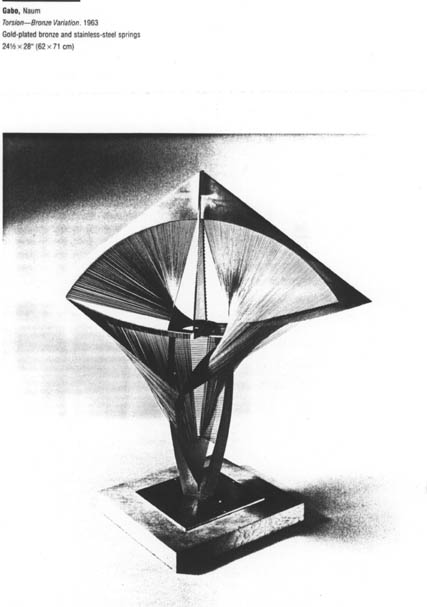
OT 9: Naum Gabo: Torsion-Bronze Variation, 1963
Picasso's Guitar and Violin, being stringed instruments, had, of course, strings. Other artists also used wire or rods in their works.
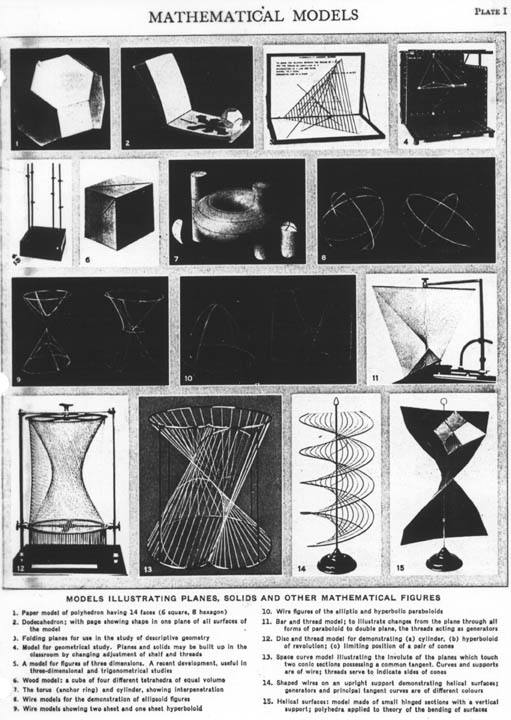
OT 10: Encyclopedia Brittanica: Mathematical Models
Henry Moore says he introduced strings in 1937 after seeing mathematical models in the science museum in London, where volumes of solids were indicated by strings threaded between geometric figures.
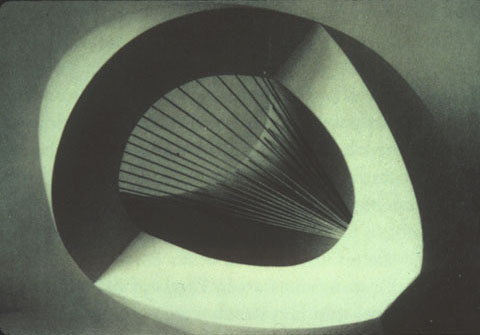
Slide 19-9: Barbara Hepworth: Sculpture with Color, 1943. Jan 826
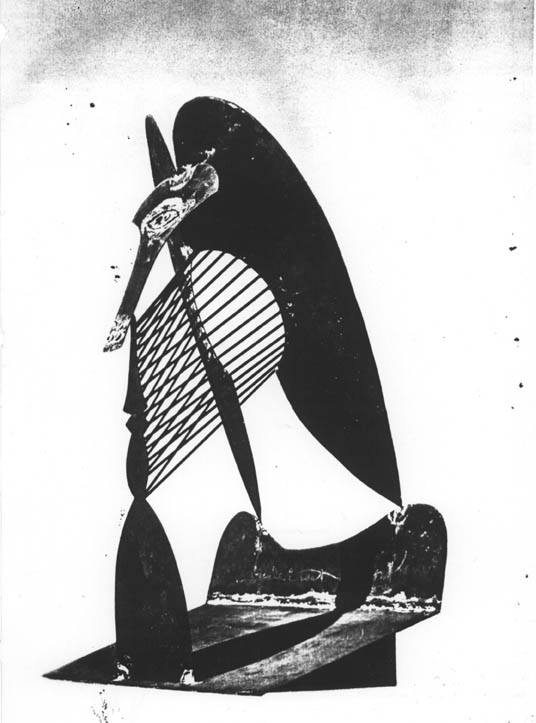
OT 12: Picasso: Chicago Civic Center sculpture, 1967
This is one of Picasso's later constructions. He did not identify it.
Suprematism
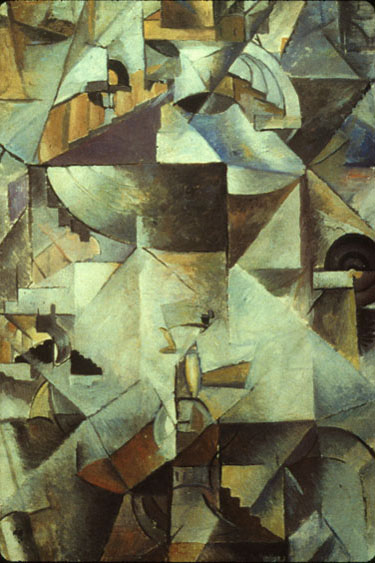
Slide 19-10: Kasimir Malevich, Samovar, c. 1913(Dab 38)
In addition to the artistic revolution of cubism and the scientific revolution of relativity there were political upheavals like the first world war. Following the war was the Russian revolution.
Malevich
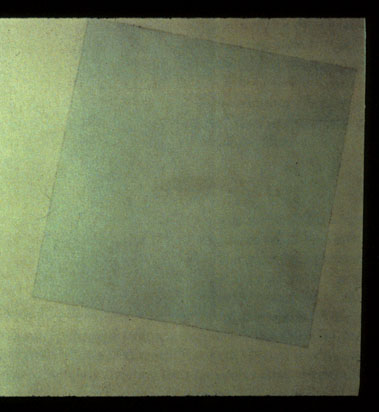
Slide 19-11: Kasimir Malevich, White on White 1918(Jan 774)
Malevich's early paintings, like Samovar, were cubist in style. Then he started searching for a means of expression compatible to modern values, to create an art for the new industrial Communist state. He and others felt that the older art had lost relevance in a society changed by industrial technology, social upheaval, and Einstein's physics. Built on cubism and Futurism, it led to a movement called Suprematism.
Suprematist paintings featured austere compositions, flat color, unstructured space, and geometric forms. Pure art to symbolize order and harmony of the new age. Its philosophical justification came in 1908 from a German philosopher Wilhelm Worringer:
". . . the urge to abstraction stands at the beginning of every art and in the case of certain peoples remains the dominant tendency . . . this urge is best served through pure geometric abstraction . . . free of all external connections with the world."
You can't be more disconnected than in this painting! Malevich had painted Black Square on White Ground, 1913, which he felt was the supreme suprematist composition, then White on White in 1918. White on White was the ultimate painting. The problem is, once you've painted the perfect painting, what do you do for an encore? Malevich quit painting and turned to architecture.
Before long this geometric art was rejected by the very audience for which intended. Russia turned to Socialist Realism, where muscular men in overalls and buxom women with babushkas are shown confidently building the new communist state.
De Stijl & Mondrian (1872-1944)

Slide 19-12: Mondrian: Composition, 1933
Piet Mondrian's early works show influence of Cubism, but gradually his paintings become more abstract. Annoyed at cubists for reversing course away from geometric abstraction, he took abstraction to its ultimate conclusion by creating total geometric abstractions. His paintings features:
simple geometrical forms
no natural forms
flat picture plane. No perspective
pure primary colors
rectangular grid
rigorous composition
De Stijl (the style) started 1917, at end of WWI, when the need for a new order was sharply felt. Like Suprematism, it too had sense of social destiny, and was very utopian. Its goals were, as for Suprematists, to create art that is a counterpart to the harmonious relations in the ideal society. De Stijl is considered the purest and most ideal of the movements.
Summary
We have seen how the new geometries of the nineteenth centuries, the scientific revolution of the early twentieth century, and the invention of photography have contributed to the radical changes in art of the early twentieth century.
We've traced some of these influences in early art movements, including Futurism, Cubism, Constructivism, Suprematism, and De Stijl. We've seen pictures become totally flat, many become totally abstract, many totally geometric, and after 500 years of development, perspective was scrapped. In a later unit, we'll continue following this thread into the late Twentieth Century
